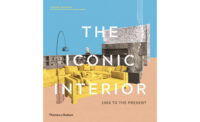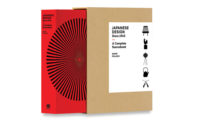On Saturday, the Cuban art duo Los Carpinteros (“The Carpenters”) opened an exhibition of new work titled Irreversible. It should be called Irreverent.
The show, which occupies the entire Sean Kelly Gallery in Manhattan through June 22, includes an 11-foot-wide architectural watercolor, a room-size installation involving smashed tomatoes, a video depicting a conga dance in reverse (music also in reverse), and three sculptures that look like spacecraft.
The “Carpenters” are Dagoberto Rodriguez and Marco Castillo, Cuban-born artists who have worked together since 1991. They now divide their time between Havana and Madrid. Their work often merges art and architecture in unexpected and amusing ways as it comments on past and present society and politics. It frequently reflects the artists’ youth in Castro’s Cuba, growing up with a government that used music, speech, and design to promise a utopian future that never arrived.
In Sean Kelly’s Toshiko Mori-designed space, they mine some of the same territory, but look further than Cuba. Here, they appropriate architectural monuments from the Communist era in the Soviet Union and other remnants of the Cold War. Their cheeky reformulations of historic Soviet icons illuminate gaps between the past and contemporary life and between utopian visions and political realities.
Robotica (2013), for example, is a rocket-like 10-foot-tall sculpture constructed from thousands of red LEGO bricks. The work is based on an actual building, the spikey, star-fruit-shaped tower that houses the Institute of Robotics and Technical Cybernetics in St. Petersburg.
“The institute is one of the most avant-garde buildings ever made,” Rodriguez said in at an interview at the gallery last week. “It was one of the last Soviet buildings, finished in 1987, made for the place where the cosmonauts trained.”
Next to it, in the shape of an Olympic trestle ski jump, is VDNKhToy, 2013, another take on a Soviet monument, this one in yellow LEGOs. It is a reference to the Monument to Conquerors of Space, a 350-foot tall statue of a soaring rocket and its contrail sheathed in glistening titanium. It opened in a park in Moscow next to the VDNKh subway stop in 1964 on the 7th anniversary of the Sputnik I launch.
Why Soviet monuments? “They are about an idea of the future,” says Rodriguez. “We grew up in a Communist country thinking only of the future. In the West, you live in the present. We grew up working for a future life, Utopia. Socialism is a bit like Christianity in that way.”
One wall in the gallery is devoted to Knin Lego (Triptico) (2012), a tripartite watercolor of a massive cement anti-tank barrier that looks like a line of jacks on steroids. Think of the Civil War barricades at Gettysburg or the World War II tank obstacles called Czech hedgehogs on the beaches of Calais. It is meticulously painted in pale grays and yellows, reflecting the sun and shadows on crossed concrete barriers that look like they could also be made of LEGOS. It is both ravishingly beautiful and off-putting. It took them three months to paint.
“We generally start out with drawings when we have an idea,” Castillo says. “It is a way for us to experiment with the concept without actually making it. This one did not become sculpture.”
The Sean Kelly exhibition devotes a separate white gallery to a wall installation titled Tomatoes (2013). For it, the artists threw 12 boxes of ripe tomatoes against three of the four walls. At the exact center of the place the tomato hit, leaving a red blotch, the artists affixed a life-size replica of a smashed tomato in fine porcelain. The walls look like a gigantic white quilt with enormous red buttons surrounded by splashes of pink.
“Throwing tomatoes is an expression of disagreement, whether it’s against a government or a bad singer,” says Castillo. “It’s how people express themselves in a rude way. People hurl tomatoes at political rallies. We’ve seen a lot of violent ambience in the streets recently in Spain. It’s impossible not to be sensitive to the situation.”
“At the same time, the installation is very aesthetic,” he continues. “It combines the gestures of throwing, a testimony of violence, with fine craftsmanship in porcelain, which also takes a lot of passion. The Spanish may be totally disappointed in their government today, but at the same time, they have a traditional society that really appreciates craft.”
The lower level of the gallery houses the video installation Conga Irreversible (2012), a performance piece the Carpenters created and filmed for the 2012 Havana Biennial. The artists worked with Yosvany Terry, a Cuban jazz artist, to create a new kind of comparasa, a traditional work by a conga band with dancers seen on city streets during Carnival. For Irreversible, 100 professional Cuban dancers in outlandish black outfits they designed were choreographed doing the conga in reverse, moving constantly backwards in formation, to the music of Terry’s newly composed conga, which was also played in reverse. The sound and dance are infectious.
“The conga is an amazing tool to bring people together,” says Castillo. “The Cuban Revolution used conga as a political rhythm; if you couldn’t keep up, you were not a revolutionary. Our work is not necessarily political but suggests another idea, that it is possible to go backwards. For the first time, using the aesthetic of folklorism, people took part in a Cuban public manifestation authorized as art.”
The video installation perfectly illustrates Los Carpinteros' strategy as artists, using irony to replace direct criticism. While they are very serious about craftsmanship in a material sense, Los Carpinteros stand out for their ability to merge architecture and design in distorted and often amusing ways to make their points.
“We use architecture as inspiration for our work. With the monuments, there is a certain nostalgia. They convey a notion of the future that never happened. It was utopian,” says Rodriquez. “What we have now is something totally different. Now we are so practical. Everything is ergonomic, all about human comfort. Something has been lost, from our point of view.”









